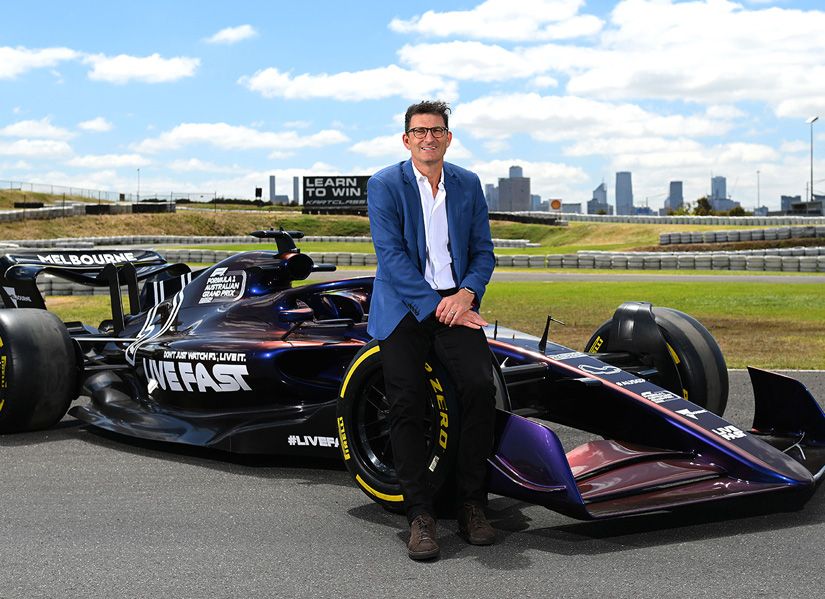
Rebecca Gundalech, 18 July, 2024
Travis Auld has had a close to 30-year career at the helm of some of Australia’s largest sporting institutions, including roles as COO of Essendon Football Club, CEO of Gold Coast Suns, and CFO of AFL Australia. Now driving the growth of the Australian Grand Prix Corporation, he leads the organisation responsible for hosting the two most prestigious international motorsport events in Australia – Formula 1 Australian Grand Prix and Australian Motorcycle Grand Prix.
Ahead of his conversation with Ellen Fanning at the upcoming QUT Business Leaders’ Forum on the 7 August, we sat down with Travis to find out more about his leadership style, how the Australian Grand Prix is trying to reduce its environmental footprint and “the Netflix effect” and the unprecedented interest in Formula 1 sweeping the country.
Who are leaders that you admire and draw inspiration from, and what qualities do you appreciate most about their leadership styles?
I have been fortunate to work closely with incredible leaders across sport, business and politics. And in my current role, more so in the international arena.
I have a number of mentors who I respect and admire greatly, however rather than draw inspiration from specific individuals, I try to have a mindset of learning from every leader I interact with or observe.
In my experience, the most powerful and effective leaders possess a number of common traits.
- They are authentic and comfortable in their own skin, with strong self-awareness
- Visionary
- High degree of integrity
- Strong ability to communicate
- They lead with care
- They are decisive, and make good decisions when it really matters
- They enjoy ownership and accountability
- They are inspirational and empowering
Can you tell me about a significant challenge you faced as a leader and how you addressed it?
I have many examples where I have had to lead under pressure or make unpopular decisions. Making decisions on coaches or players, leading during COVID, being the inaugural CEO of a new AFL club.
In sport, you are leading and making decisions under the public microscope. Results are measured and published often daily and people are analysing and judging every decision you make. And that analysis is rarely objective.
It’s about having clear plan and being able to stay the course despite outside pressures. Leading in sport is not a popularity contest.
It is important to develop a sense of what is background noise and what is real. If you are responding to noise you will jump from issue to issue without making real progress.
How did you navigate the career you’ve had – did you always know what you wanted to do? What influenced your career decisions?
I have always taken a fluid approach to my career. My approach has been to take opportunities as they present themselves, be prepared to take on responsibilities outside of my direct remit and put myself in positions that stretch and challenge me.
This has allowed me to work across many different disciplines and build a wide range of skills and experiences.
While I have been open minded about my career direction, there is a constant thread throughout my career in that I have always performed best in organisations that have a deep sense of purpose, impact and connection with community. That is where sport has resonated with me.
How is the Australian Grand Prix promoting sustainability and reducing its environmental footprint?
In order to reduce our impact, we first needed to measure and understand our environmental footprint. In 2022, AGPC conducted its first scope 1,2 and 3 carbon audit of the Formula 1 Australian Grand Prix, Australian Motorcycle Grand Prix and the organisations office and storage facilities. In 2023 we conducted a second audit to ensure improved data quality and have taken the 2023 Green House Gas (GHG) emissions audit as our organisational benchmark.
Looking forward we move towards action and reduction using the data insights from our GHG benchmarking as the foundations. Moving into 2024 AGPC is working with ESG consultants to develop the organisations ESG strategy and carbon reduction roadmap. These important strategies are a demonstration to our stakeholders of AGPC’s commitments and targets in the Environmental, Social and Governance space.
Over the 3 years of AGPCs Sustainability journey there have been significant improvements to reduce our environmental impact. In the energy space we have reduced our scope 2 emissions by procuring 100% Certified Green Power for all grid supply electricity and where temporary power is required a 5% Bio-Fuel has been trailed and in 2023 the FORMULA 1 AUSTRALIAN GRAND PRIX was proudly the first major event in Australia to use Hydrogen Cell Generators operationally.
Responsible consumption and reduction of waste is also a focus and in 2024 the FORMULA 1 AUSTRALIAN GRAND PRIX achieved an 81% diversion from landfill and with the assistance of food rescue charities Oz Harvest and Second Bite, 11 tonnes of food was collected and distributed to those in need throughout Melbourne (this is the equivalent of 22,000 meals worth).
To promote sustainability, there must also be the initiatives in place to assist our fans in making sustainable decisions. In all general admission areas water refill stations were metered to improve data capture and to accurately measure use. 61,301 litres of water was consumed which is the equivalent of 122,602 500ml plastic bottles saved from landfill, and reusable plates and bowls were used in a fan zone resulting in 15,927 items washed and reused.
To promote active and public transport to our event, additional tram and bus services run throughout the event period, and e-scooter and e-bike parking is available. In 2024, 82% of fans used public and active transport to reach our event.
Moving forward the Australian Grand Prix is committed to consistent improvements over time, with the aim to combine initiatives and programs which will result in Green House Gas reductions and improvements in our environmental impact performance.
The 'Netflix Effect' has been credited with helping revive interest in F1 racing. How do you view this impact and what other initiatives are being implemented to grow the fan base in Australia?
“Drive to Survive” has proven to be one of the great game changes in the history of sport and entertainment. It has had a transformative impact on Formula 1 by growing its audience, enhancing its appeal to a younger demographic, and providing a behind the scenes perspective on the sport that resonates with both new and existing fans. Many sports around the world have since tried to emulate it, with varying degrees of success.
The series has deepened fan engagement through providing behind-the-scenes access and personal stories, humanising the sport and turning its participants into stars.
The Australian Grand Prix has been a beneficiary on this global surge in popularity. Crowds in Melbourne have grown 50% since pre COVID, bringing a new demographic to the sport – in 2024, 43% of attendees were female (10% higher than the global average), 44% between the ages of 16-34, and over 1/3 of attendances were attending the Australian Grand Prix for the first time.
This change in demographic brings with it enormous opportunities. It also requires us to evolve the experience to keep pace with the growth and change in profile of attendees.
Having two Australian drivers on the grid also plays a really important role in driving interest and engagement.
As a respected leader in the sporting world, what challenges do you see Australia facing as it heads toward the hosting of the Olympic and Paralympic Games in 2032?
Australia will embrace the opportunity to host the Olympic and Paralympic Games in Brisbane in 2032. We are very proud of our Olympians and Paralympians who have historically done incredibly well on the world stage, and we enjoy showcasing our country.
The event will present some challenges at a macro level that will need to be worked through to ensure the success of the games.
The main challenge relates to infrastructure. Building and upgrading infrastructure to accommodate the influx of athletes, officials, and spectators is a significant undertaking. This includes venues, transportation and accommodation.
The investment into infrastructure, along with the costs associated with hosting an event of this scale, will require substantial funding. This is at a time when State and Federal budgets are being challenged, and cost of living pressures are becoming more apparent.
A successful Games will require the support of the community, particularly the local Brisbane community. The community will need to see the economic and social benefits for the state, including a clear proposition in legacy mode.
